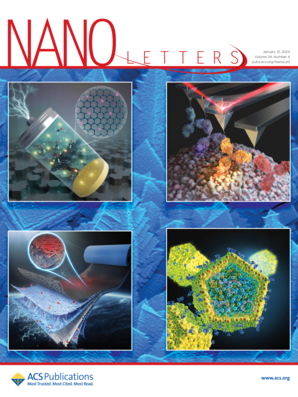Synthesis of Nanographene–DNA Conjugates and Their Profiling with MoS2 Nanopores
IF 9.6
1区 材料科学
Q1 CHEMISTRY, MULTIDISCIPLINARY
引用次数: 0
Abstract
We demonstrate the possibility of covalently bonded hybrid DNA–graphene materials by synthesizing a model DNA–polycyclic aromatic hydrocarbon (PAH) conjugate comprising a 33mer oligonucleotide containing thymine and uridine modified with bispyrenyl benzene. This DNA–PAH conjugate (T13UPAHT19; T = thymine, UPAH = PAH-modified uridine) has an atomically thin nanographene protrusion extending by only about 1 nm from the single-stranded DNA (ssDNA). We show that DNA–PAH conjugates can be characterized with high resolution by profiling with a nanopore in a monolayer MoS2 membrane. The profiling experiments provided sufficient resolution to distinguish the thymine and PAH-modified regions of T13UPAHT19 and confirm the asymmetry of the PAH attachment relative to the 3′ and 5′ ends of the ssDNA due to different lengths of the T13 and T19 segments. This work provides the foundation for further exploration of DNA–graphene hybrids, demonstrating an example of their synthesis and the utility of nanopore profiling for their structural characterization with an ∼1 nm resolution.

求助全文
约1分钟内获得全文
求助全文
来源期刊

Nano Letters
工程技术-材料科学:综合
CiteScore
16.80
自引率
2.80%
发文量
1182
审稿时长
1.4 months
期刊介绍:
Nano Letters serves as a dynamic platform for promptly disseminating original results in fundamental, applied, and emerging research across all facets of nanoscience and nanotechnology. A pivotal criterion for inclusion within Nano Letters is the convergence of at least two different areas or disciplines, ensuring a rich interdisciplinary scope. The journal is dedicated to fostering exploration in diverse areas, including:
- Experimental and theoretical findings on physical, chemical, and biological phenomena at the nanoscale
- Synthesis, characterization, and processing of organic, inorganic, polymer, and hybrid nanomaterials through physical, chemical, and biological methodologies
- Modeling and simulation of synthetic, assembly, and interaction processes
- Realization of integrated nanostructures and nano-engineered devices exhibiting advanced performance
- Applications of nanoscale materials in living and environmental systems
Nano Letters is committed to advancing and showcasing groundbreaking research that intersects various domains, fostering innovation and collaboration in the ever-evolving field of nanoscience and nanotechnology.
 求助内容:
求助内容: 应助结果提醒方式:
应助结果提醒方式:


